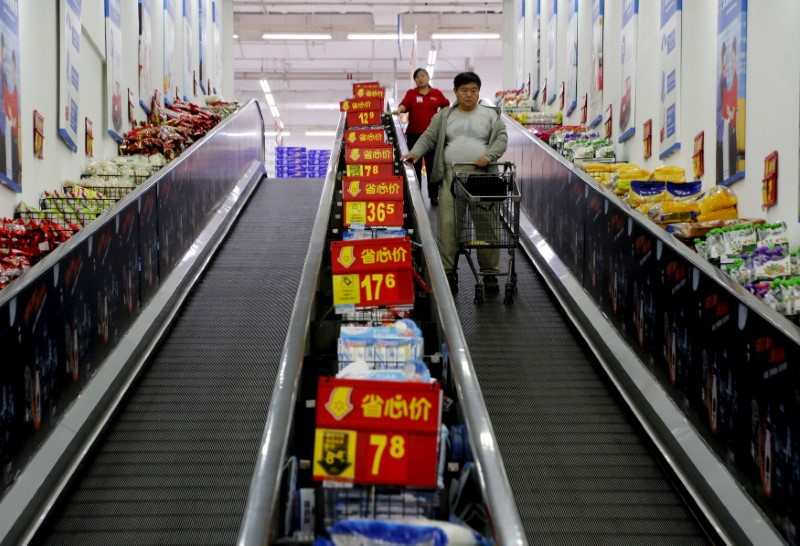(Bloomberg) -- After fueling its V-shaped recovery by boosting spending on housing and infrastructure, China appears in no rush to drop its investment-led growth model despite international calls for it to “rebalance” its economy.
First quarter data released Friday underlined just how reliant China remains on its current approach: investment spending rose 6% compared with a 4.2% increase in retail sales, based on two-year average growth rates to strip out base effects from last year’s coronavirus lockdowns.
The International Monetary Fund and others have long argued that China’s unusually heavy dependence on investment in infrastructure and property has led to an unbalanced economy. While it’s helped to fuel decades of rapid growth, critics say it’s also led to a reliance on debt -- which could spark a financial crisis -- and overcapacity in the economy, as has happened in the past in industries like steel and coal.
Raising the share of household consumption would help to “rebalance” the economy, the argument goes. At about 43% of gross domestic product, China has one of the highest investment ratios of any major economy, while consumption is about 38%.
Justin Yifu Lin, a former chief economist at the World Bank who was an adviser to President Xi Jinping last year, said in an interview that calls for consumption-led growth “are not supported by empirical evidence or economic theory.” He argues that high investment in new infrastructure and equipment enables workers to be more productive and raises their income, in turn increasing consumption.
“If I’m an ordinary person what I care about will be the growth rate of consumption. We’d like to have higher consumption, but not necessarily a higher consumption ratio,” he said. Any increase in China’s consumer spending share in the next five years “will be gradual,” he said.
Growth Sources
That message is echoed by the central bank. In a working paper last week, People’s Bank of China researchers led by Chen Hao wrote that “consumption has never been a source of growth” and that “we attach importance to investment.” They singled out the U.S. as a warning, arguing that excessive consumption and low savings fueled a large trade deficit and contributed to the 2008 global financial crisis.
The pandemic increased China’s gap between investment and consumption as Beijing aimed financial aid at companies to resume production, rather than handing cash to households. The U.S. Treasury said in a report last week that China’s lack of government support for households had fueled its rising trade surplus in 2020, calling on Beijing to “take decisive steps” to allocate more resources to consumers.
Lin says declining household consumption and an increased trade surplus are short-term effects of the pandemic and Beijing doesn’t need aggressive policies to counter them.
“Once the world returns to a normal situation I think the structure will spontaneously adjust back to the more balanced pattern,” he said.
In the longer term, because China is the leading producer of consumer goods but relies on other countries for raw materials it uses for investment, increasing the consumption share would not have a direct effect on the country’s trade surplus, Lin said. China’s current account surplus, the broadest measure of trade in goods and services, fell below 2% of GDP before the coronavirus pandemic, even as it maintained a high investment rate.
The share of consumer spending in China’s GDP will increase at a slower pace in the next few years and economic growth still needs the support of investment, said Xu Hongcai, deputy director of the China Association of Policy Science’s economic policy committee, a think tank affiliated with the ruling Communist Party’s Central Committee. There’s still a lack of infrastructure to support urbanization and an aging population, he added.
There are other indications that Beijing’s consumption push will be muted. The government’s latest five-year plan released last month predicts that the share of household income in GDP, the main determinant of consumer spending power, will remain roughly constant through to 2025. Beijing plans to invest the equivalent of trillions of dollars in digital infrastructure and green energy over the next five years.
‘Demand-Side Reforms’
Late last year, the Communist Party called for “demand-side reform,” a pledge that many interpreted as emphasizing policies aimed at creating a more equal distribution of household income. Since those with lower incomes tend to save less, re-distributive policies could increase consumption without raising the overall household income share.
Yet the five-year plan shifted language to “demand side management,” which is a “less ambitious formulation,” according to Andrew Batson, a China research director at Gavekal Dragonomics. Bejing has announced plans to increase consumption this year, but “none of these policy goals are associated with quantitative targets, or seem sizable enough to move the needle on aggregate consumer spending,” Batson wrote in a note. “The government does not actually have a plan to boost consumption.”
Some Chinese economists worry that investment spending is too low, rather than too high. Former central bank adviser Yu Yongding last week argued for a faster rate of increase in government infrastructure spending to boost growth, dismissing fears that added debt will increase financial risks.
“An inadequate economic growth rate will increase, rather than reduce, vulnerabilities of the financial environment,” he wrote in the state-run China Daily.
©2021 Bloomberg L.P.
